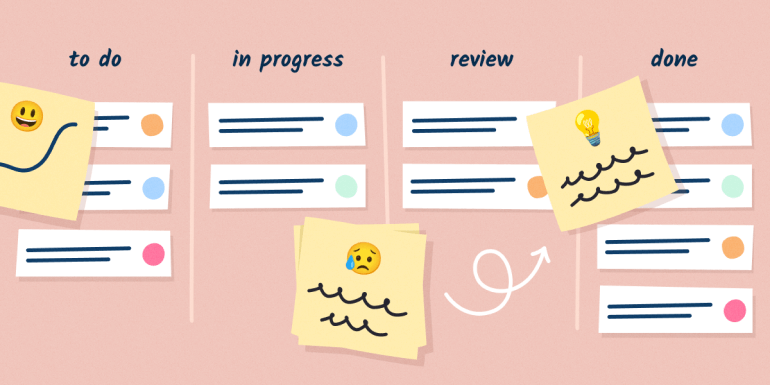4 Tactics to Run Retrospectives with your Kanban Team


In Scrum, the Sprint retrospective is an essential team event. The team takes time, at the end of each Sprint, to inspect and adapt its ways of doing things in order to deliver more value to its customers.
The retrospective is at the heart of the team's continuous improvement and fits perfectly with the last principle of the Agile Manifesto:
“At regular intervals, the team reflects on how to become more effective, then tunes and adjusts its behavior accordingly.”
- Manifesto for Agile software development
But how do you run retrospectives and foster continuous improvement in your team when working with Kanban?
What are the differences with a retrospective in Scrum?
In this article, I will show you different ways to incorporate retrospective meetings with your Kanban team:
Classic Retrospective
The first option is to do it like a Scrum team by performing an Agile retrospective on a recurring basis.
Unlike Scrum, where different events are planned and included in each Sprint, in Kanban, each meeting will create a context change for the team.
The first step is to decide on a cadence with your team, and agree on:
A day of the week and a time (e.g., Tuesday at 2 p.m.)
A duration (e.g., maximum 1h30)
A recurrence (e.g., every three weeks)
This planning should be seen as an experiment. The goal is to try different cadences until you find the one that works best for your team.
For the conduct of this meeting, I advise you to take a look at our complete guide on Agile retros.
Service Delivery Review
The Service Delivery Review is a meeting where the team inspects the Kanban board. For each element of the board, the team will reflect on the problems encountered and will try to find ways to improve.
Just like a classic Agile retrospective, the first step will be to define the cadence at which you will conduct this meeting. Usually once and twice a month.
After gathering your team, share the Kanban board. Start from the Done column and go through each task. Discuss the problems encountered and the learnings.
At the end of each discussion, create an action plan to prevent the problems encountered from coming back, or to improve your practices based on what you have learned.
💡 Neatro tip: To get the most value from the discussions, focus on the facts and not on the people. This will allow the team to have a higher level of psychological safety.
After going through all the tasks on the Kanban board, you can do the same with your team metrics. These metrics can relate to value delivered to customers, efficiency or productivity.
The important thing is to decide as a team on which metrics it is most important to take action. Analyzing the evolution of these metrics over time is an effective way to prioritize them. You can also use your Cumulative Flow Diagram.
Stop The Line
The Stop The Line technique is a concept used by Toyota in their production lines. It allows any member of a team to interrupt production if a problem is encountered. Once production is halted, a retrospective meeting will be immediately scheduled to understand the issue and create an action plan.
The goal of this technique is to bring the team together and solve the problem as quickly as possible. However, it creates several risks:
Too many interruptions
Difficulties in organizing these meetings quickly
So only use the Stop The Line technique with the most critical issues. For example, a major security breach or a production problem to be resolved within 24 hours.
💡 Neatro tip: To save as much time as possible, use an online retrospective tool.
For all the other issues, there is a retrospective method based on the events and not on a cadence: The Pull system.
The Pull System
The principle of a pull system is to do things when you really need them. It is the opposite of a push system which relies on forecasts to send tasks into production.
For example, Kanban is a Pull System. A task only advances in the flow if the previous task has advanced.
To determine when you need something, a pull system will be based on events. It is this principle that we will use for our retrospectives.
The team must have access to an online retrospective tool in which a retrospective will be opened. Anyone on the team can add ideas or issues to this retro at any time.
Once three items have been added, the team should automatically schedule the next retrospective. Generally, it takes place immediately after the next daily meeting, but you can also schedule it for later. The sooner the better!
This meeting could be a classic Scrum retro or a Service Delivery Review. The important thing is to focus on the three ideas that had been added to it.
💡 Neatro tip: Collect your team's feedback on the retrospective by performing a ROTI.
You can apply this principle of asynchronous retrospective without setting a limit, it will however be necessary to respect a cadence.
That’s it! 4 tactics to implement retrospective meetings in your Kanban team.
The most important thing is to let your team experiment and invent their own way of doing retrospectives. Regardless of the technique, the goal is to continuously improve the value your team delivers to its customers.
If you want to deepen your knowledge of the team retrospective, do not hesitate to consult our complete guide.
Have a great retro! :)



